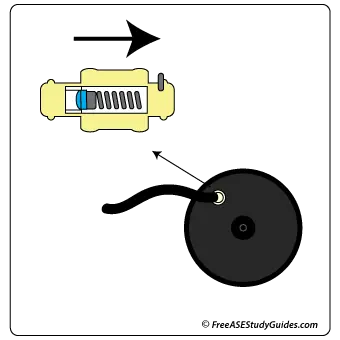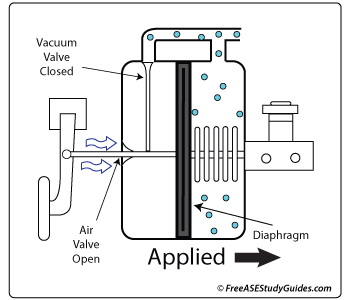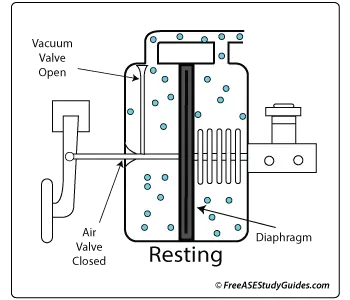Power brake booster vacuum
#1
Power brake booster vacuum
Now that I am getting closer to starting the engine up for the first time in 40 years, I am looking for info on hooking up the vacuum line to the power brake booster.
I am planning on using the same port on the manifold that was originally for the wipers. The fitting on the booster appears to be a 3/8" hose barb.
If I run the same size tubing to the manifold will I get enough vacuum from the intake manifold to operate the brakes?
Thanks in advance for any help on this!
I am planning on using the same port on the manifold that was originally for the wipers. The fitting on the booster appears to be a 3/8" hose barb.
If I run the same size tubing to the manifold will I get enough vacuum from the intake manifold to operate the brakes?
Thanks in advance for any help on this!
#2
Don't know if the 54's Y-block (?) wiper connection is like the flatheads', but if so, No, it isn't big enough to quickly evacuate the booster. It may be 3/8" hose (I think it's 1/4") but the passages in the manifold are tiny. Take off your carb and look at them, they are 1/16" holes on flatheads.
#3
#4
The best way to ensure that you have a sufficient supply of vacuum for your brakes is to add an electric vacuum pump system. I have seen many vehicles with power brakes that do not stop well due to insufficient vacuum...the electric pump resolves this problem handily.
#5
http://www.summitracing.com/search/P...-Pumps-Street/
Here are just a few...I use the SSBC pump on my 40 Ford coupe for two reasons; one, I can keep all the hoses under the floor and two, it works ALL the time with no adverse effects from loads on the engine.
Here are just a few...I use the SSBC pump on my 40 Ford coupe for two reasons; one, I can keep all the hoses under the floor and two, it works ALL the time with no adverse effects from loads on the engine.
#6
The best way to ensure that you have a sufficient supply of vacuum for your brakes is to add an electric vacuum pump system. I have seen many vehicles with power brakes that do not stop well due to insufficient vacuum...the electric pump resolves this problem handily.
#7
http://www.summitracing.com/search/P...-Pumps-Street/
Here are just a few...I use the SSBC pump on my 40 Ford coupe for two reasons; one, I can keep all the hoses under the floor and two, it works ALL the time with no adverse effects from loads on the engine.
Here are just a few...I use the SSBC pump on my 40 Ford coupe for two reasons; one, I can keep all the hoses under the floor and two, it works ALL the time with no adverse effects from loads on the engine.
Trending Topics
#9
Picking the Proper Vacuum Hose For Your Brake System | Master Power Brakes
It wouldn't hurt to open up the port and use a 1/4"NPT fitting if you can do it, with full-size drilling all the way into the intake. Like I said earlier on the flatheads they have a decent sized fitting but inside the manifold they reduced way down.
#10
Good resource Ross, I wish they spent a little more time on what size vacuum line is appropriate for a given application. I would think that the size of the booster would have something to do with the size of the line but I haven't seen anything in print about that. There is also a question in my mind regarding the length of the vacuum line...once a vacuum is drawn I would think that the length of the line would not matter so much but I may be missing something. I too am running a vacuum reservoir, I got one off an old Eldorado I junked...price was right and it works great.
#11
Vacuum is a funny thing, Charlie. Pipe/hose size does matter to a point, but it also increases the volume that has to be evacuated. There isn't much "flow" really, because ultimately a booster system is a closed system, until the brakes are applied then released.
Does your reservoir have large connections like a booster, or is it only used to store vacuum for the HVAC controls, etc.?
Does your reservoir have large connections like a booster, or is it only used to store vacuum for the HVAC controls, etc.?
#12
#14
Depending on how much you care about vacuums here is a research paper on the subject: http://www.chem.elte.hu/foundations/...ika/CERN01.pdf.
You are never going to get a perfect vacuum to form however that does not really matter for our application. I would think that one of the most important factors for brakes would be the time to form the vacuum. This should be proportional to the length of the line . From my understanding the vacuum port on the carb is not always operating in a vacuum but instead rapidly shifting back and forth. Because the check valve is on the booster and not on the carb the line also goes from vacuum to non vacuum. This leads me to believe that if the line was to long then a vacuum would not be able to form at all on the booster end(although a vacuum would be formed towards the carb end). Not completely sure if this is correct but it makes sense in my head.
You are never going to get a perfect vacuum to form however that does not really matter for our application. I would think that one of the most important factors for brakes would be the time to form the vacuum. This should be proportional to the length of the line . From my understanding the vacuum port on the carb is not always operating in a vacuum but instead rapidly shifting back and forth. Because the check valve is on the booster and not on the carb the line also goes from vacuum to non vacuum. This leads me to believe that if the line was to long then a vacuum would not be able to form at all on the booster end(although a vacuum would be formed towards the carb end). Not completely sure if this is correct but it makes sense in my head.
#15
Vacuum is formed by the passage of air through the carb and down into the cylinders. As the piston drops it pulls fuel/air into the cylinder creating vacuum. At idle the vacuum is highest since the butterflies in the carb are pretty much closed yet the pull from the cylinders is still the same. As the engine RPM increases the butterflies are farther open letting more air flow through and into the cylinders at a higher rate causing the vacuum to drop.
The problem with low vacuum arises when the pistons are not sealed well to the cylinder wall...ie, worn rings, or when the cam grind is such that it allows too much overlap between intake and exhaust cycles for a vacuum to be held at an acceptable level. Assuming that you have correct vacuum, here is what happens at the booster:
Vacuum brake assist units use a large round flexible diaphragm enclosed in an assembly to create two distinct vacuum chambers. The pedal side of the diaphragm has two valves attached to the pedal arm. These valves work together to control booster operation. A booster check valve allows vacuum into the booster when manifold vacuum is high and traps it in when manifold vacuum is low. It's a one way check valve that allows air to flow in only one direction.
 A brake booster needs the right amount of vacuum to operate correctly. This is typically engine manifold vacuum (17-21Hg). On some engines, particularly diesels, an auxiliary pump is used to create vacuum. This vacuum is applied to both sides of the booster. Both the pedal side and the master cylinder side.
A brake booster needs the right amount of vacuum to operate correctly. This is typically engine manifold vacuum (17-21Hg). On some engines, particularly diesels, an auxiliary pump is used to create vacuum. This vacuum is applied to both sides of the booster. Both the pedal side and the master cylinder side.
As the driver presses the brake pedal, the vacuum valve blocks the vacuum source located on the pedal side of the booster. At the same time the air valve moves allowing atmospheric pressure in. Sometimes a slight hissing noise can be heard as the air rushes past the filter, through the air valve and into the chamber.
 This collapse in vacuum on the pedal side accompanied with the vacuum source still applied to the master cylinder side produces a powerful brake assist. This is because of the pressure differential caused by the closing vacuum valve and the opening air valve. The flexible diaphragm located in the center of the assembly provides an air tight seal. A rod or "power piston" is connected to this diaphragm. This push-rod is mechanically connected to the diaphragm and through the entire unit. One end is connected directly to the master cylinder and the other is connected to the brake pedal. This mechanical connection is why vacuum brake booster failure will not result in a complete loss of braking action. There is always a connection between the two.
This collapse in vacuum on the pedal side accompanied with the vacuum source still applied to the master cylinder side produces a powerful brake assist. This is because of the pressure differential caused by the closing vacuum valve and the opening air valve. The flexible diaphragm located in the center of the assembly provides an air tight seal. A rod or "power piston" is connected to this diaphragm. This push-rod is mechanically connected to the diaphragm and through the entire unit. One end is connected directly to the master cylinder and the other is connected to the brake pedal. This mechanical connection is why vacuum brake booster failure will not result in a complete loss of braking action. There is always a connection between the two.
 When the driver releases the brake pedal, a return spring located in the center of the master cylinder side of the booster assembly returns the diaphragm to its resting position. While the spring moves the diaphragm, the air and vacuum valves are also returned to their normal positions. This returns vacuum to both sides of the diaphragm. This is known as it's balanced or at rest position. Brake booster failure will leave a vehicle with a hard brake pedal. Remember, vacuum assist brake units require sufficient vacuum to operate correctly. Sometimes this vacuum is blocked at the intake manifold port. A kink in the check valve hose will also result in this hard brake pedal condition. Cleaning this port or repairing the check valve's hose will restore vacuum and brake booster operation.
When the driver releases the brake pedal, a return spring located in the center of the master cylinder side of the booster assembly returns the diaphragm to its resting position. While the spring moves the diaphragm, the air and vacuum valves are also returned to their normal positions. This returns vacuum to both sides of the diaphragm. This is known as it's balanced or at rest position. Brake booster failure will leave a vehicle with a hard brake pedal. Remember, vacuum assist brake units require sufficient vacuum to operate correctly. Sometimes this vacuum is blocked at the intake manifold port. A kink in the check valve hose will also result in this hard brake pedal condition. Cleaning this port or repairing the check valve's hose will restore vacuum and brake booster operation.
My apologies to the online study guide from which I lifted this very detailed writeup.
The problem with low vacuum arises when the pistons are not sealed well to the cylinder wall...ie, worn rings, or when the cam grind is such that it allows too much overlap between intake and exhaust cycles for a vacuum to be held at an acceptable level. Assuming that you have correct vacuum, here is what happens at the booster:
Vacuum brake assist units use a large round flexible diaphragm enclosed in an assembly to create two distinct vacuum chambers. The pedal side of the diaphragm has two valves attached to the pedal arm. These valves work together to control booster operation. A booster check valve allows vacuum into the booster when manifold vacuum is high and traps it in when manifold vacuum is low. It's a one way check valve that allows air to flow in only one direction.
 A brake booster needs the right amount of vacuum to operate correctly. This is typically engine manifold vacuum (17-21Hg). On some engines, particularly diesels, an auxiliary pump is used to create vacuum. This vacuum is applied to both sides of the booster. Both the pedal side and the master cylinder side.
A brake booster needs the right amount of vacuum to operate correctly. This is typically engine manifold vacuum (17-21Hg). On some engines, particularly diesels, an auxiliary pump is used to create vacuum. This vacuum is applied to both sides of the booster. Both the pedal side and the master cylinder side.As the driver presses the brake pedal, the vacuum valve blocks the vacuum source located on the pedal side of the booster. At the same time the air valve moves allowing atmospheric pressure in. Sometimes a slight hissing noise can be heard as the air rushes past the filter, through the air valve and into the chamber.
 This collapse in vacuum on the pedal side accompanied with the vacuum source still applied to the master cylinder side produces a powerful brake assist. This is because of the pressure differential caused by the closing vacuum valve and the opening air valve. The flexible diaphragm located in the center of the assembly provides an air tight seal. A rod or "power piston" is connected to this diaphragm. This push-rod is mechanically connected to the diaphragm and through the entire unit. One end is connected directly to the master cylinder and the other is connected to the brake pedal. This mechanical connection is why vacuum brake booster failure will not result in a complete loss of braking action. There is always a connection between the two.
This collapse in vacuum on the pedal side accompanied with the vacuum source still applied to the master cylinder side produces a powerful brake assist. This is because of the pressure differential caused by the closing vacuum valve and the opening air valve. The flexible diaphragm located in the center of the assembly provides an air tight seal. A rod or "power piston" is connected to this diaphragm. This push-rod is mechanically connected to the diaphragm and through the entire unit. One end is connected directly to the master cylinder and the other is connected to the brake pedal. This mechanical connection is why vacuum brake booster failure will not result in a complete loss of braking action. There is always a connection between the two. When the driver releases the brake pedal, a return spring located in the center of the master cylinder side of the booster assembly returns the diaphragm to its resting position. While the spring moves the diaphragm, the air and vacuum valves are also returned to their normal positions. This returns vacuum to both sides of the diaphragm. This is known as it's balanced or at rest position. Brake booster failure will leave a vehicle with a hard brake pedal. Remember, vacuum assist brake units require sufficient vacuum to operate correctly. Sometimes this vacuum is blocked at the intake manifold port. A kink in the check valve hose will also result in this hard brake pedal condition. Cleaning this port or repairing the check valve's hose will restore vacuum and brake booster operation.
When the driver releases the brake pedal, a return spring located in the center of the master cylinder side of the booster assembly returns the diaphragm to its resting position. While the spring moves the diaphragm, the air and vacuum valves are also returned to their normal positions. This returns vacuum to both sides of the diaphragm. This is known as it's balanced or at rest position. Brake booster failure will leave a vehicle with a hard brake pedal. Remember, vacuum assist brake units require sufficient vacuum to operate correctly. Sometimes this vacuum is blocked at the intake manifold port. A kink in the check valve hose will also result in this hard brake pedal condition. Cleaning this port or repairing the check valve's hose will restore vacuum and brake booster operation.My apologies to the online study guide from which I lifted this very detailed writeup.



